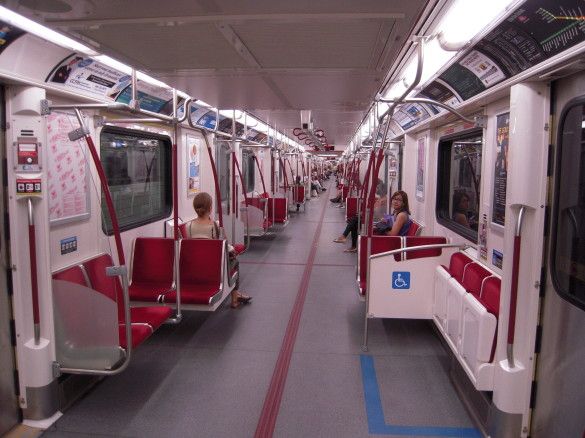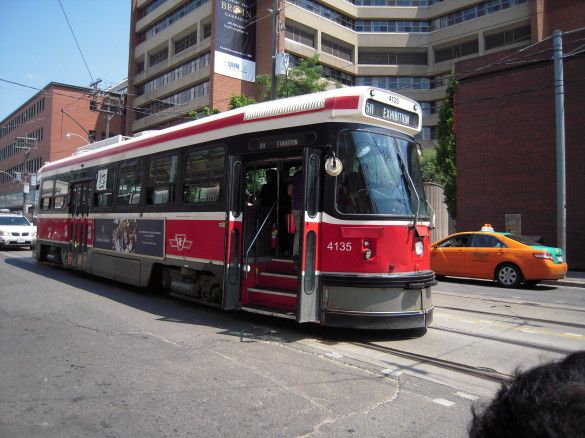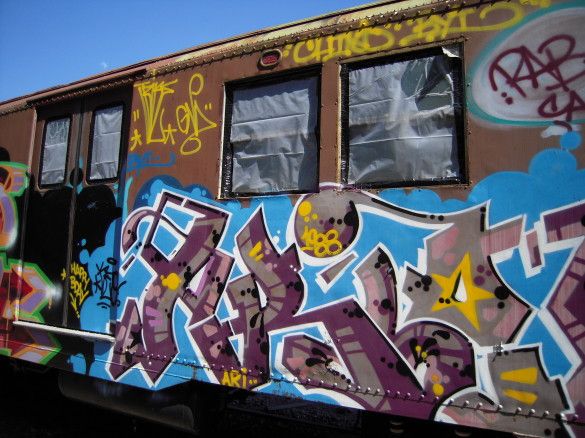The Commute: My Vacation In Canada And Upstate New York – Part 1 Of 2

THE COMMUTE: I recently came back home from a week-long vacation in Niagara Falls and Toronto, Canada. I also stopped off on the way back in Albany and Kingston, New York. I will spare you the hundreds of photos and videos of Niagara Falls, and will concentrate only on the transit- and transportation-related aspects of the trip.
Bunching Is Also A Problem In Toronto
Let’s start with that beautiful looking picture of a Toronto subway train. I loved the open effect of being able to see through the cars and easily walk between cars to even out passenger loads. From what I remember, the MTA considered ordering similar cars at the time of the last subway car purchase, but for whatever reason decided against it. After all, if you could walk easily between cars, how could you give summonses for it? But seriously, there must have been other reasons why the MTA instead chose the design we currently have. It would be nice, however, if the MTA would have revealed its rationale, rather than just ask us to trust that they made the best possible decision, which I do not believe they always do.
Now, for the title of this section. Notice I didn’t say “bus bunching.” That is because, during my three days in Toronto, I hardly saw any buses except for tour buses. In Downtown, there are mostly subways and streetcars, or trolleys. We had no problems at all with the subways. However, it seemed whenever we took a trolley, we were delayed, twice having to wait about a half-hour for one. They also seemed to be operating at least two at a time.

The first time, the operator apologized for the delay claiming there was an accident preventing the cars from getting through. He said he preferred not to start his shift that way and thanked everyone for his or her understanding. He also made a public announcement each time someone gave up a priority seat for the elderly, calling those people “angels.”
No apology announcements were made for any of the other delays. A round about trip on the subway would have been quicker than a direct trolley ride on one of our excursions. On most trolley routes, the right-of-way is shared with automobiles, which didn’t seem to pose any problems traffic-wise. New York City gave up its last trolley in 1956. One of the reasons was that, without refuge islands and the increasing number of cars on the road, it was no longer safe for pedestrians to board in the center of the street.
I would have to agree with that. In Toronto, when a streetcar stops to pick up and discharge passengers, a stop sign on the inside of the doors tells cars to stop and give the pedestrians the right of way, much like the stop signs now on school buses. All the cars obey. Somehow, I guess because so few cars give pedestrians the right of way at intersections in New York City, I just can’t imagine that scenario working here without many pedestrians getting killed before cars realize they have to stop.
Another difference between Toronto and New York is that, when surface transit is running late, the operators instruct everyone with a pass to board through the rear door and be honest about it in order to minimize delays. Other than SBS, bus operators in New York City who allow boarding through the rear door risk being reprimanded for doing that, although it may be a transfer point in which virtually everyone is transferring from the train and no revenue would be lost. Toronto also has some routes in which you can board through any door and require proof of payment, as well as a Downtown Express bus requiring an extra fare, but I didn’t see or ride on those routes.

On at least one streetcar route, along Spadina Avenue (pictured above, and pronounced with a long “A”), the streetcars have their own right of way down the center of the street with their own stations. The route is also not very long. It is difficult for me to understand why that route experienced the greatest amount of bunching I encountered, with at least four streetcars arriving all crowded and at the same time after a 30-minute wait. If bunching occurs there, why should we believe the MTA that a similar configuration — either in the center or sides of Woodhaven Boulevard for SBS, which is presently being studied — would improve service?
One noticeable difference between Spadina Avenue and Woodhaven Boulevard is that Spadina has numerous parallel ‘through’ streets to accommodate cars and trucks, so that the exclusive right of way does not cause traffic back-ups, even in the rush hour, whereas Woodhaven has no through parallel streets to accommodate displaced traffic. Because of this, traffic on Woodhaven is greatly worsened. That is not to say that Toronto has no traffic problems during its rush hours. It does. We got stuck in the car on a parkway that looked more like a parking lot, with a 29-minute wait until the next exit. Local streets were not much better.
Kingston, New York

On the way home, we stopped in Kingston. In addition to it being a very nice historic district, Kingston is also the home of the New York Trolley Museum. The museum houses a few old European trolleys and gives trolley rides. It also houses several former New York City subway cars, one of which is adorned in graffiti. I wonder if those vandals, or “artists,” as some refer to them, ever realized their work would someday be exhibited in a museum.
In the museum, the ridiculousness of a 1904 notice appearing on street railway transfer tickets, obviously written by lawyers, caught my attention. It read: “Whoever uses a transfer ticket in violation of any such condition, or whoever uses or attempts to use a transfer ticket not issued to him, or whoever for value disposes of or attempts to dispose of a transfer ticket issued to him to any other person, or whoever for value delivers or attempts to deliver a transfer ticket not issued to him to any person, shall be punished by a fine not exceeding FIFTY DOLLARS, or by imprisonment for a term not exceeding THIRTY DAYS.”
Were they kidding? Fifty dollars in 1904 or 30 days in jail (I presume for those not having $50) for misusing a transfer? What was the penalty for fare evasion? Probably death for not paying your nickel.
Next Week: The fare, driving in Toronto, and more.
The Commute is a weekly feature highlighting news and information about the city’s mass transit system and transportation infrastructure. It is written by Allan Rosen, a Manhattan Beach resident and former Director of MTA/NYC Transit Bus Planning (1981).
Disclaimer: The above is an opinion column and may not represent the thoughts or position of Sheepshead Bites. Based upon their expertise in their respective fields, our columnists are responsible for fact-checking their own work, and their submissions are edited only for length, grammar and clarity. If you would like to submit an opinion piece or become a regularly featured contributor, please e-mail nberke [at] sheepsheadbites [dot] com.




